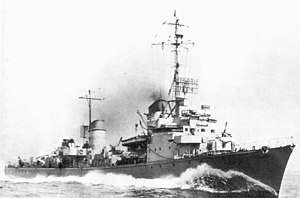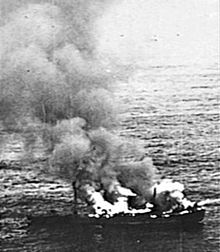German torpedo boat T24
 Sister ship T35 in US service, August 1945
| |
| History | |
|---|---|
| Name | T24 |
| Ordered | 10 November 1939 |
| Builder | Elbing, East Prussia |
| Yard number | 1483 |
| Laid down | 21 September 1940 |
| Launched | 13 September 1941 |
| Completed | 17 October 1942 |
| Fate | Sunk by air attack, 24 August 1944 |
| General characteristics (as built) | |
| Class and type | Type 39 torpedo boat |
| Displacement |
|
| Length | 102.5 m (336 ft 3 in) o/a |
| Beam | 10 m (32 ft 10 in) |
| Draft | 3.22 m (10 ft 7 in) |
| Installed power |
|
| Propulsion |
|
| Speed | 33.5 knots (62.0 km/h; 38.6 mph) |
| Range | 2,400 nmi (4,400 km; 2,800 mi) at 19 knots (35 km/h; 22 mph) |
| Complement | 206 |
| Sensors and processing systems | |
| Armament |
|
The German torpedo boat T24 was one of fifteen
Design and description
The Type 39 torpedo boat was conceived as a general-purpose design, much larger than preceding German torpedo boats.
As built, the Type 39 ships mounted four
Construction and career
Originally ordered as a
After
Battle of the Bay of Biscay

On 24–26 December T24 was one of the escorts for the 6,951

The German ships were unaware of the sinking until the following afternoon and continued onward to the rendezvous point. They had been spotted by an American Liberator bomber on the morning of the 28th and the British light cruisers
Subsequent activities
On the night of 21/22 April 1944, the 4th Flotilla, now consisting of T24 and her sisters
After emergency repairs, T27 joined T24 in Saint-Malo during the night of 26/27 April. The sisters departed Saint-Malo bound for Brest on the night of 28/29 April and were spotted by British coastal radar. They were intercepted by Haida and Athabaskan off Île Vierge. Haida opened the engagement by firing a star shell at 04:12; the Germans laid a smoke screen in response and turned away. The sisters fired all of their torpedoes as they turned, T24 firing three off the wrong side of the boat, but one of the others hit Athabaskan. Shortly afterwards, she blew up, probably from a magazine explosion, and sank at 04:42. Haida pursued T27, badly damaging her. While maneuvering, T27 accidentally ran aground and the Canadian destroyer continued to engage until she started a large fire and then returned to the site where Athabaskan had sunk to rescue survivors. T24 and a pair of minesweepers failed in their attempt to pull T27 off and then T24 rescued 47 survivors from Athabaskan on the way to Brest. She struck a mine en route, but was only damaged.[12] The 4th Torpedo Boat Flotilla was then disbanded and the boat was assigned to the 8th Destroyer Flotilla. After repairs, T24 was ordered to Cherbourg on 19 May, but struck another mine and was under repair for the next several weeks.[12]
On the night of 8/9 June, the four ships of the 8th Flotilla set out from Brest for Cherbourg, but were intercepted by eight Allied destroyers of the

On the night of 14/15 August, T24, two minesweepers and
Notes
Citations
- ^ Whitley 1991, p. 52
- ^ Gröner, p. 195
- ^ Sieche, p. 239
- ^ Whitley 1991, pp. 54, 203
- ^ Friedman, p. 205; Whitley 1991, pp. 52–55; Whitley 2000, p. 73
- ^ Hervieux, p. 96; Rohwer, pp. 256–257, 259, 269; Whitley 1991, pp. 144–145, 212
- ^ Whitley 1991, p. 149
- ^ Rohwer, pp. 294–295; Whitley 1991, p. 149
- ^ Hervieux, p. 98; Rohwer, p. 295; Whitley 1991, pp. 149–153
- ^ O'Hara, p. 203
- ^ Hervieux, p. 99; Rohwer, pp. 317–318; Whitley 1991, pp. 156–157
- ^ a b Hervieux, p. 100; Rohwer, pp. 318, 324; Whitley 1991, pp. 157, 159
- ^ Hervieux, p. 100; Rohwer, p. 332; Whitley 1991, pp. 158–161
- ^ Gröner, p. 195; Hervieux, p. 100; Rohwer, p. 347; Whitley 1991, pp. 162–163
References
- ISBN 0-85177-238-2.
- ISBN 0-87021-790-9.
- Hervieux, Pierre (1986). "The Elbing Class Torpedo Boats at War". In Lambert, Andrew (ed.). Warship X. London: Conway Maritime Press. pp. 95–102. ISBN 0-85177-449-0.
- O'Hara, Vincent P. (2004). The German Fleet at War, 1939–1945. Annapolis, Maryland: Naval Institute Press. ISBN 1-59114-651-8.
- ISBN 1-59114-119-2.
- Sieche, Erwin (1980). "Germany". In Chesneau, Roger (ed.). Conway's All the World's Fighting Ships 1922–1946. London: Conway Maritime Press. ISBN 0-85177-146-7.
- ISBN 1-85409-521-8.
- Whitley, M. J. (1991). German Destroyers of World War Two. Annapolis, Maryland: Naval Institute Press. ISBN 1-55750-302-8.
Further reading
- Whitby, Michael (2022). "The Challenges of Operation 'Tunnel', September 1943 — April 1944". In Jordan, John (ed.). Warship 2022. Oxford: Osprey Publishing. pp. 29–46. ISBN 978-1-4728-4781-2.
